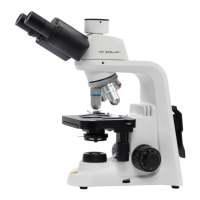17
VI. Using oil immersion objectives
●
Oil immersion objectives are labelled with the additional engraving “Oil”
and are to be immersed in oil between the specimen and the front of the
objective.
●
The immersion oil supplied by Swift is synthetic, non-uorescing and non-
resining oil, with a refractive index of 1.515
●
Normally, cover glass must be used with oil immersion objectives with a
few exceptions. Deviations from thickness are not important as a layer of
immersion oil acts as compensation above the cover glass.
●
The small bottle of oil supplied with every immersion objective facilitates
application of the oil to the cover slip.
●
Remove any air bubbles in the nozzle of the oil container before use.
●
Immersion oil must be used sparingly. After the examination, the oil
should be wiped o the objective with a lens cleaning tissue and the
residual lm removed with soft cloth moistened with petroleum benzene
or absolute alcohol.
●
Locate the eld of interest with a lower magnication objective. Swing the
objective out of the light path, and add one drop of immersion oil over the
site of the specimen. Swing in the oil immersion objective. There should
be a small column of oil from the cover slip to the objective lens. Use the
ne focus to make the image sharp.
●
Freedom from air bubbles must be ensured. To check for air bubbles,
remove an eyepiece, fully open the eld and aperture diaphragms, and
look at the exit pupil of the objective within the eyepiece tube. Air bubbles
are recognized by presence of a surrounding black ring. Bubbles may
often be dislodged by moving the slide to and fro or by slightly rocking
the revolving nosepiece back and forth. If not successful in clearing the
bubbles then the oil must be wiped o and replaced with a fresh drop.

